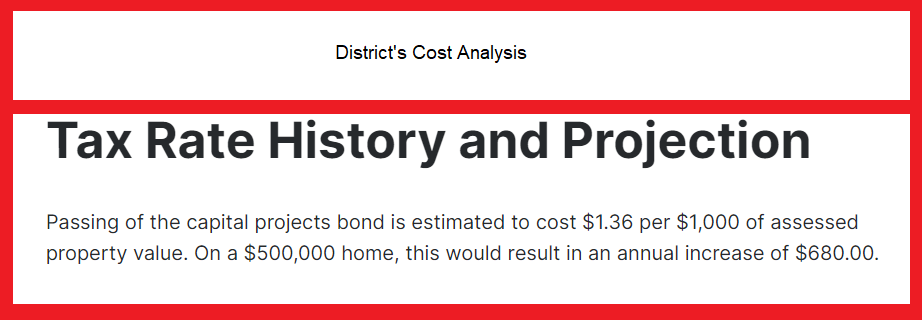An Analysis Of School Districts' Cost Impact Analyses Of Their August 6th 2024 Tax Measures
Last updated: April 26th, 2024
Contents
- Summary
- Analysis details for each tax measure’s district created cost impact analysis
Summary
From a review of the school district generated property tax cost impact analyses regarding tax measures on the April 2024 election (and on previous elections since 2020), it is abundantly clear that Truth In Lending Act (TILA) type guidelines are sorely needed regarding school district tax measures. Most school districts are quite creative in how they present cost impact information. There is no standardization. Taxpayers/voters are often confused by the districts’ presentations and have no real idea on what the true cost impacts will be.
An often used cost analysis technique by school districts is to present guesstimated future tax rates covering multiple future years. This practice is nonsense. Guesstimated future tax rates depend on guesstimated future Total AVs (assessed values) of all district tax area properties in each future year of the tax measure. The author has shown (using basic Algebra) that the only future rates that should be shown, if any, should be based on the current year’s known Total AV.
See the proof on this link
Link to the August 6 2024 report
and the demonstration calculator on this link
Link to the calculator showing the irrelevance of future guesstimated tax rates
Taxpayers expect and deserve a logical and accurate accounting of the multi year property tax cost impacts of the school district tax measures that are on the ballot. It is expected that the TILA guidelines be voluntarily followed. TILA guidelines are of course mandatory for banks (home mortgages), car loan agents, and credit card companies. School districts should be teaching and students should be learning about TILA.
Link to a brief summary of TILA from the Office of Financial Readiness
Almost all school districts make the logic and math error of assuming a guesstimated Total AV growth each year of their tax measure while keeping the AV of their example property constant. This misleads voters and underestimates the tax burden on taxpayers. The Yelm School District in Thurston County however provides an online calculator, similar to the author’s, that correctly allows their example property’s AV to change at the same pace as the Total AV. Other school districts should learn from Yelm.
Summary of school districts’ cost analysis scores and grades
| Lead County | School District | Tax Measure Type | Score | Grade |
|---|---|---|---|---|
| Whatcom | Lynden | Bond | -10 | F |
The rubrics used are described below. Possible score: 100
For bonds and levies:
| Criterion | Penalty |
|---|---|
| Did the district not provide the total estimated tax obligation for just this measure for an example property? | -50 |
| If the district did provide an example property’s cost impact | |
| Was the district’s estimate greater than 5% of the author’s logical estimate? | -5 |
| Was the district’s estimate greater than 10% of the author’s logical estimate? | -5 |
| Was the district’s estimate greater than 20% of the author’s logical estimate? | -10 |
| Was the district’s estimate greater than 30% of the author’s logical estimate? | -10 |
| Was the district’s estimate greater than 40% of the author’s logical estimate? | -10 |
| Did the district not state estimated tax rates based on the known 2024 AVs? | -40 |
Additionally for bonds:
| Criterion | Penalty |
|---|---|
| Did the district not clearly state and quantify bond principal, interest and fees? | -10 |
| Did the district not provide the actual total bond cost (principal + est interest and fees) for an example property? | -10 |
| Did the district not clearly state (or show in a graph) the taxes to collect each future year of the bond for an example property showing any increases from one year to the next? | -10 |
Analysis details for each tax measure’s district created cost impact analysis
Whatcom County, Lynden SD, Bond
The district’s property tax cost impact analysis (from the district’s website) is shown in the next image with the red border

| Criterion | Penalty |
|---|---|
| Did the district not provide the total estimated tax obligation for just this measure for an example property? | |
| If the district did provide an example property’s cost impact | |
| Was the district’s estimate greater than 5% of the author’s logical estimate? | -5 |
| Was the district’s estimate greater than 10% of the author’s logical estimate? | -5 |
| Was the district’s estimate greater than 20% of the author’s logical estimate? | -10 |
| Was the district’s estimate greater than 30% of the author’s logical estimate? | -10 |
| Was the district’s estimate greater than 40% of the author’s logical estimate? | -10 |
| Did the district not state estimated tax rates based on the known 2024 AVs? | -40 |
| Did the district not clearly state and quantify bond principal, interest and fees? | -10 |
| Did the district not provide the actual total bond cost (principal + est interest and fees) for an example property? | -10 |
| Did the district not clearly state (or show in a graph) the taxes to collect each future year of the bond for an example property showing any increases from one year to the next? | -10 |
Score: -10
Grade: F
Link to the author’s logical, interactive, cost impact calculator